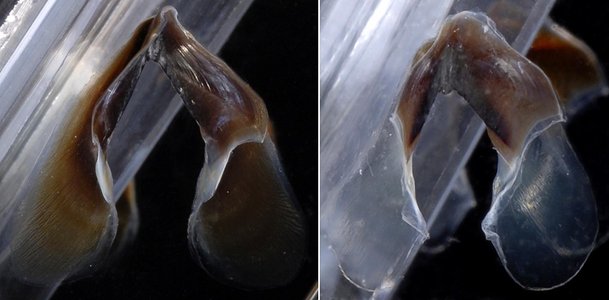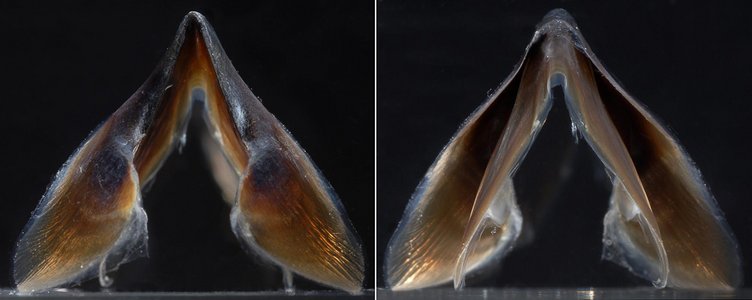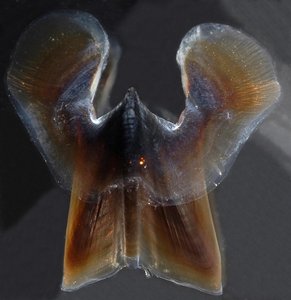We examined eight beaks of Mg. microlucens, but obtained measurements from only five individuals (95, 127, 150, 190, 215 mm ML). The following characters are taken from Clarke (1986). Means are used, when possible, for measurements.
- Pigmentation - Light side of normal; often fades greatly after removal.
- Pigmentation pattern - At 95 mm ML the wing has a very light pigment over most of its surface.
- (Wing length)/(visible rostral edge) (profile) - 2.11
- Height/baseline (profile) - 0.85 (n=4)
- (Length from rostral tip to wing tip projected on baseline)/(baseline) (profile) - 0.27
- (Hood llength)/(crest length) (profile) - 0.51
- (Crest length)/baseline (profile) - 0.61
- (Rostral base)/(visible rostral edge) (profile) - 1.08
- (Hood length)/(visible rostral edge) (profile) - 0.96
- Rostral width ratio [LRL/(length between jaw angles)] - 1.47 (n=4)
- Wing angle (= visible jaw angle in profile) - Obtuse.
- Shape of jaw edge - Almost straight but with small, gradual, sometimes abrupt, hook.
- Rostrum (profile) - Broad taper to tip.
- Hood distance from crest - Close to crest.
- Crest - Nearly straight.
- Lateral wall notch - Virtually absent.
- Hood-wing - Broad.
- Hood notch - Broad, shallow to deep.
- Lateral walls to free corner - Broadly separated with increasing but low divergence from one another.
- Hood midline - Moderately curved.
- Hood surface without prominent longitudinal ridges or grooves.
- Wing fold - Low, rounded, obscures jaw angle in profile.
- Shoulder - Shoulder blades well developed in one beak (95 mm ML) where they are large and trapezoidal with oral ends projecting very slightly.
- Shoulder groove - Absent to moderate.
- Jaw angle - Strongly obtuse, without associated step or transparent strip.
- Jaw edge extension - Extends well beyond shoulder padding and terminates in a sharp or blunt angle point well short of lateral wall edge.
- Terminal shoulder filling pigmentation - Distinct. Final stage not observed.
- Jaw edge in cross-section - Sharp.
- Crest in cross-section - Somewhat broad to narrow.
- Lateral wall - Lateral-wall ridge present, does not reach posterior edge of lateral wall; medial surface of lateral wall opposite ridge flat (ie, no groove).


Figure. Left and right side views of the same lower beak of Mg. microlucens, 215 mm ML, 5.2 mm LRL, mature male, Hawaiian waters. Photographs by R. Young.


Figure. Left and right side views of the same lower beak of Mg. microlucens, 95 mm ML, 2.8 mm LRL, immature female, Hawaiian waters. Photographs by R. Young. Left image modified from Young, et al. (2008)


Figure. Left and right side-oblique views of the same lower beak of Mg. microlucens, 215 mm ML, mature male, Hawaiian waters. Photographs by R. Young.


Figure. Oblique rear-views of the lower beak of M. microlucens, Hawaiian waters, showing the width of the lateral wall ridge (arrow). Left - 215 mm ML, mature male. Right - 95 mm ML, immature female. Photographs by R. Young.


Figure. Posterior views of the lower beak of Mg. microlucens, Hawaiian waters, showing the absence of a groove associated with the lateral wall ridge. Left - 215 mm ML, mature male. Right - 95 mm ML, immature female. Photographs by R. Young.


Figure. Lower beak of Mg. microlucens, mm ML, 190 mm ML (estimated), 4.8 mm LRL, Hawaiian waters. Left - Side view of the lower beak that has been cut in half and laid flat with drawn cross-sections of the lateral wall overlayed where the cuts occurred. Right - Side view of the same beak, standing upright, before it was cut. The pigment of the beak had mostly faded giving the beak a translucent appearance. Photographs by R. Young.


Figure. Front (left) and rear (right) views of the same lower beak of Mg. microlucens, 215 mm ML, mature male, Hawaiian waters. Photographs by R. Young.


Figure. Top view of the lower beak of Mg. microlucens, 215 mm ML, mature male, Hawaiian waters. Photographs by R. Young.
Comments
Mg. microlucens beaks tend to lose their pigmentation over time in alcohol. Mg. microlucens is easly separated from its closest relative among broad-beaked mastigoteuthids (ie, Mg. magna) by the absence of a low lateral-wall fold (present in Mg. magna) but the presence of an anterior, solid, lateral-wall ridge (fold slightly thickened in Mg. magna but doesn't form a distinct ridge). The fold in Mg. magna extends to the posterior margin of the lateral wall whose shape is modified by it. In contrast no modification occurs at this point in Mg. microlucens whose lateral-wall ridge doesn't extend that far. Mg. microlucens is separated from the other broad-beaked mastigoteuthid (Idioteuthis cordiformis) by the lateral-wall fold in Idioteuthis cordiformis, the greater elevation of the hood above the crest in Idioteuthis cordiformis (no. 14), the lesser extension of the wings (no. 5 above) in Idioteuthis cordiformis, probably the greater rostral width ratio (no. 10), possibly a lesser wing angle in Idioteuthis cordiformis (no. 11) and possibly a broader crest in Idioteuthis cordiformis.
UPPER BEAK


Figure. Side views of the upper beaks of Mg. microlucens, Hawaiian waters. Left - 190 mm ML, sex unknown. Right - 215 mm ML, mature male.


Figure. Various views of the upper beak of Mg. microlucens, 215 mm ML, mature male, Hawaiian waters. Left - Top view. Middle - Bottom view. Right - Front view. Photographs by R. Young.
Comments.
We were unable to separate Mg. microlucens upper beak from that of its close relative Mg. magna. It is distinguished from most other beaks, except Idioteuthis cordiformis, by the low height of the crest within the rostrum and from Idioteuthis cordiformis by the lesser height of the hood above the crest relative to the hood-rostrum length (C-Ht/Ct-Rt). In addition the pigmentation of Mg. microlucens is much lighter than in Idioteuthis cordiformis.




 Go to quick links
Go to quick search
Go to navigation for this section of the ToL site
Go to detailed links for the ToL site
Go to quick links
Go to quick search
Go to navigation for this section of the ToL site
Go to detailed links for the ToL site